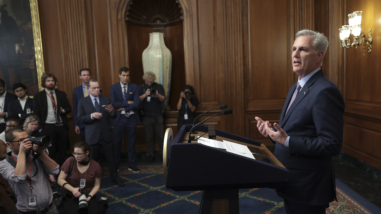Madison Initiative Program Officer Kelly Born wrote this piece as a guest post for the Social Velocity blog. It appeared there earlier this week. -Ed.
In March of 2014, the William and Flora Hewlett Foundation launched a new initiative focused on US democracy reform, The Madison Initiative. The overarching goal is to “help create the conditions in which Congress and its members can deliberate, negotiate, and compromise in ways that work for more Americans.”
Our mandate is for a 3-year, exploratory initiative to assess whether and how the Foundation might be able to make a difference here. During this period, we are focused on three central questions:
- Are there solutions and approaches that are worth pursuing?
- Is there ample grantee capacity to pursue these ideas (or can we help build it)?
- Are there funding partners we can work with to make it happen?
In exploring this problem of congressional dysfunction we realized early on that, unfortunately, there don’t appear to be any silver-bullets that will solve this problem – it’s not as if campaign finance reform, nonpartisan redistricting, or increased voter turnout, taken on their own, would resolve our current democratic ails (even setting aside for the moment how hard it would be to actually achieve these changes!).
Regrettably, there is no clear consensus on what to do to improve the system, much less on how to do it. This may be, in part, why Inside Philanthropy awarded The Madison Initiative with 2014’s Big Foundation Bet Most Likely to Fail. Given this, our view has been that current congressional dysfunction is occurring in a system of systems (and sub-systems) that are interacting in complicated ways.
Early on we decided to develop a systems map rather than a theory of change to guide our work (working in close partnership with the Center for Evaluation Innovation and Kumu, collaborations we’ve written a bit about here). Theories of change typically outline desired (social or environmental) outcomes and then map backwards, linearly, to the activities and inputs necessary to achieve those outcomes. Systems maps are perhaps better suited for more complex, uncertain environments like democracy reform, where cause-and-effect relationships can be entangled and mutually reinforcing, rather than unidirectional.
Version 1.0 of our map includes more than 35 variables we believe are contributing to the problem, distributed across three key domains: Congress, Campaigns and Elections, and Citizens. In light of this complexity, rather than making an initial set of big bets on a few key variables, we have instead spread a series of smaller bets within these systems to see where grantees might gain traction, and what this reveals about the system’s more confounding parts.
The benefits of this approach are many – in fact, I cannot imagine effectively tackling this particular problem any other way. But employing this spread betting approach also involves a few challenges for us at Hewlett, and for our partners and grantees. The trade-offs are worth considering:
- We are acknowledging and respecting complexity, but this can sow seeds of confusion for our partners. Our approach has the essential benefit of taking into account the systemic complexity and interdependency of what we are trying to help change. We are avoiding over-simplifying and thereby misconstruing our reality (a good thing). But we are exploring more than 35 variables (ranging from deteriorating bipartisan relationships to the proliferation of partisan news media), with more than 60 active grantees. This approach can be hard to manage, and harder still to convey to others – especially anyone accustomed to a more linear and readily understandable theory of change.
- Our course correcting helps us learn, but has a real impact on partners. As we diversify our investments to learn more about what works, we will continue to learn more about which efforts are having the most impact on congressional dysfunction, and which are less germane to the problem. As we do, we will necessarily converge (and double down) on a few core interventions, while discontinuing others. This will mean disappointing organizations that we respect and had supported at the outset – an inevitable byproduct of this approach, but unpleasant for all involved.
- Our evidence-based approach risks coming off as overly academic. We are determined to avoid investing in solutions where there is not solid evidence to support their viability vis-à-vis our goals. This helps us avoid squandering funds on interventions that won’t, ultimately, work. But this approach also runs the risk of coming across as standoffish, academic, and idiosyncratic in the eyes of a practitioner-driven field that in some instances may be pursuing work that is harder to (or has yet to be) substantiated by solid research.
We’ve certainly got our work cut out for us. But we deeply believe that the social sector shouldn’t shy away from complex problems. We also believe that the benefits of this approach far outweigh the costs. It enables broad-based learning, and truly forces us to constantly re-think the grants we are making. Building in these tough choices, rather than forging ahead with a pre-defined strategy, requires that we not just learn, but that we act on what we discover. And fast.
In short, while beset by a few real challenges, we’re convinced that an emergent path is the best path forward. Surely we will place some wrong bets along the way. But, as a favorite colleague of mine often says, “it’s not like we’re selling cigarettes to children.” All of our grantees are doing great work – ultimately it will (not so simply) be a question of which of these lines of work is most likely to improve Congress.
In 2017, we will go back to our Board of Directors to discuss whether and how The Madison Initiative’s work will continue. In the meantime, we would love to hear how other funders have approached emergent problems like this – and how nonprofits might advise that we manage these inherent challenges as we progress?



